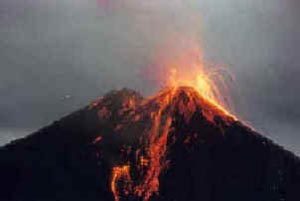If you live in Costa Rica the time to worry is nigh – or not, depending on how optimistic you feel. US geologists have pinned down the timing of recent catastrophic eruptions in the central valley of Costa Rica that suggest the next major volcanic event will occur within the next few hundred thousand years.
Speaking at the annual meeting of the Geological Society of America in April, in Puerto Vallarta, Mexico Phillip Gans, of the University of California, Santa Barbara, told his audience that although the Costa Ricans were not around for the last big one, the next is inevitable. Another pyroclastic flow like the last one big one in Costa Rica will make the Mount St. Helens eruption look like nothing! he exclaimed. Like most geological events major volcanic eruptions are so infrequent that prediction on the human timescale is irrelevant; the eruption might happen in five or five hundred thousand years, it is impossible to say for certain.

Phillip Gans
It is not that we don’t think there will be any warning, he later told Spotlight, it is that we don’t know what the warning signs will be like and whether we will be able to tell whether these signs are indicative of a large or just another small eruption. Several of the volcanoes around the central valley are currently active, but their activity for the past 300 thousand years has been of mainly small eruptions.
The volcanoes in Costa Rica are formed by subduction. An oceanic tectonic plate sliding under the country initiates melting deeper in the Earth. The molten magma rises to the surface and erupts as volcanoes, producing pyroclastic flows, lava flows, and ash fall deposits. Pyroclastic flows are high-speed avalanches of hot ash, rock fragments, and gas that race down the sides of volcanoes during explosive eruptions or when the steep edge of a dome breaks apart and collapses. These pyroclastic flows, move at over 100 km per hour, knocking down and burning everything in their path with scorching matter at more than 500 Celsius.

Arenal volcano
While volcanoes are unpredictable beasts, says Gans, Mount St. Helens provided a four-month warning, revealing its intent through small earthquakes within the volcano, monitored with sensitive seismic equipment. 25 people died in the eruption, but the majority were evacuated in plenty of time.

Mt St Helens
We don’t know if we will get a similar warning for a very large eruption like the ones that have occurred prehistorically in the Central Valley of Costa Rica, explains Gans. The Central Plateau of Costa Rica is home to more than half of Costa Rica’s population and is flanked by several large volcanoes, some of which are still active.
Gans has spent many years dating with great precision hundreds of rock samples from Costa Rica, using the radioactive decay of potassium. The data he has accrued has allowed him to piece together a detailed history of volcanic activity in the region as well as to create a geological map of the country. His latest prediction was the result of research carried out with G. Alvarado-Induni and W. Perez of the University of Costa Rica in San Jose, Costa Rica, Master’s student Ian MacMillan of the University of California, Santa Barbara; and Andrew Calvert of the US Geological Survey in Menlo Park, California.
Subduction-related volcanism has been taking place in Costa Rica for at least 24 million years, according to Gans’ calculations. Major pyroclastic eruptions have been commonplace during the last million years in the vicinity of the Central Valley of Costa Rica; the most recent was about 324,000 years ago. Indeed, the cities and towns here, including the capital San Jose are built on the pyroclastic flow deposits produced by that eruption. A pyroclastic flow today of that magnitude would bury them all in tens of metres of hot rock and ash. Just a few days warning could save thousands of lives.
To predict an eruption a dense array of seismographs will be needed to spot characteristic tremors, detailed surveys and levelling data must be recorded to indicate whether the ground surface is moving upward on the flanks or at the summit of the volcano. Increased hot springs activity around and at the summit of the volcano provides a third indicator of a likely eruption. The Costa Ricans are definitely doing some of this type of monitoring, Gans told us, but not to the same degree that was done at Mount St. Helens.
Further reading
Phillip Gans
http://www.geol.ucsb.edu/faculty/gans/
US Geological Survey
http://www.usgs.gov/
Suggested searches
Costa Rica
Volcanoes
Subduction
Pyroclastic flows